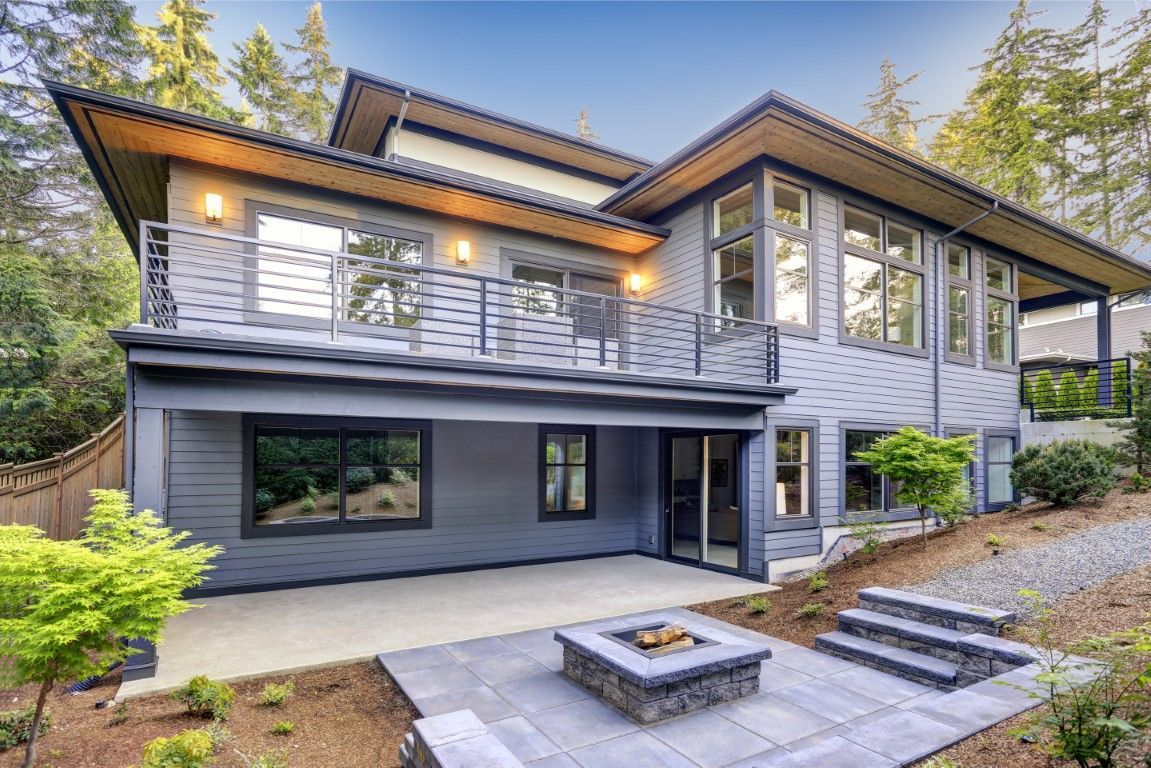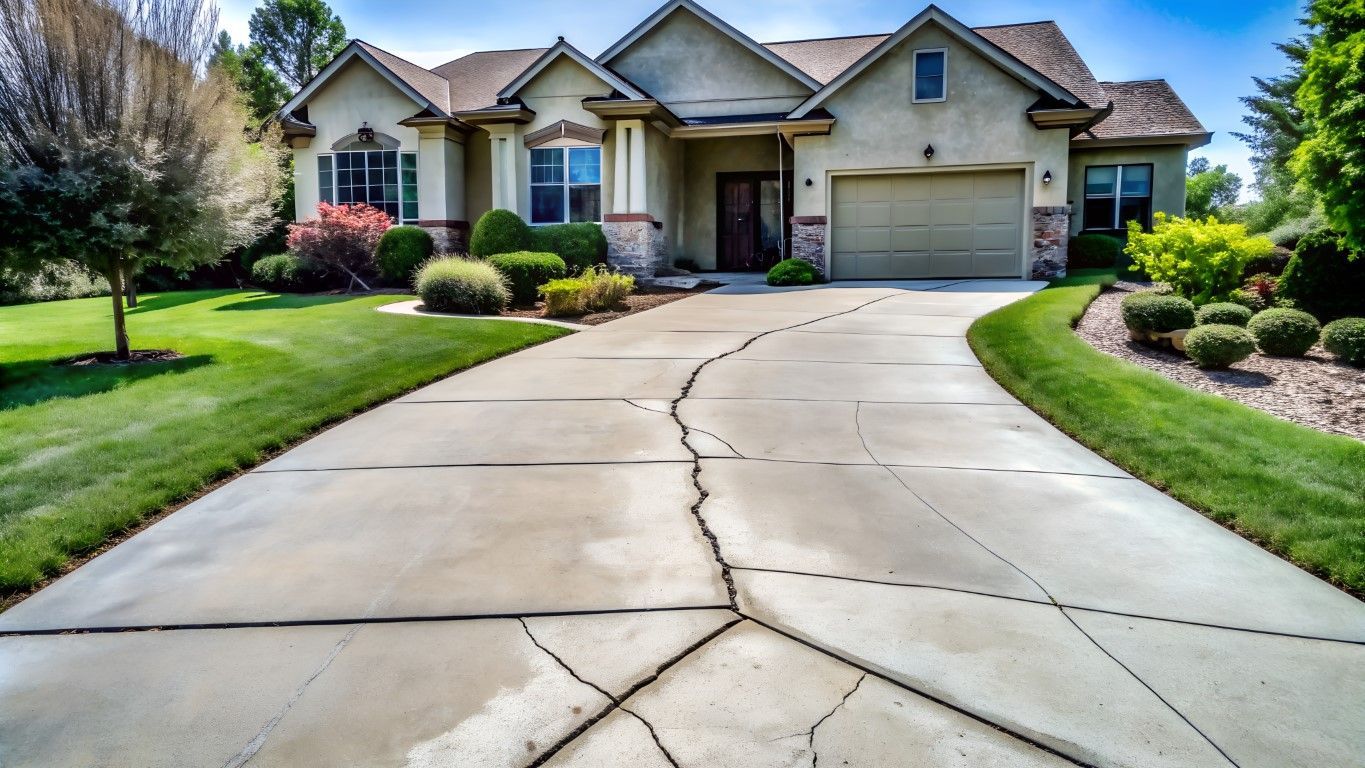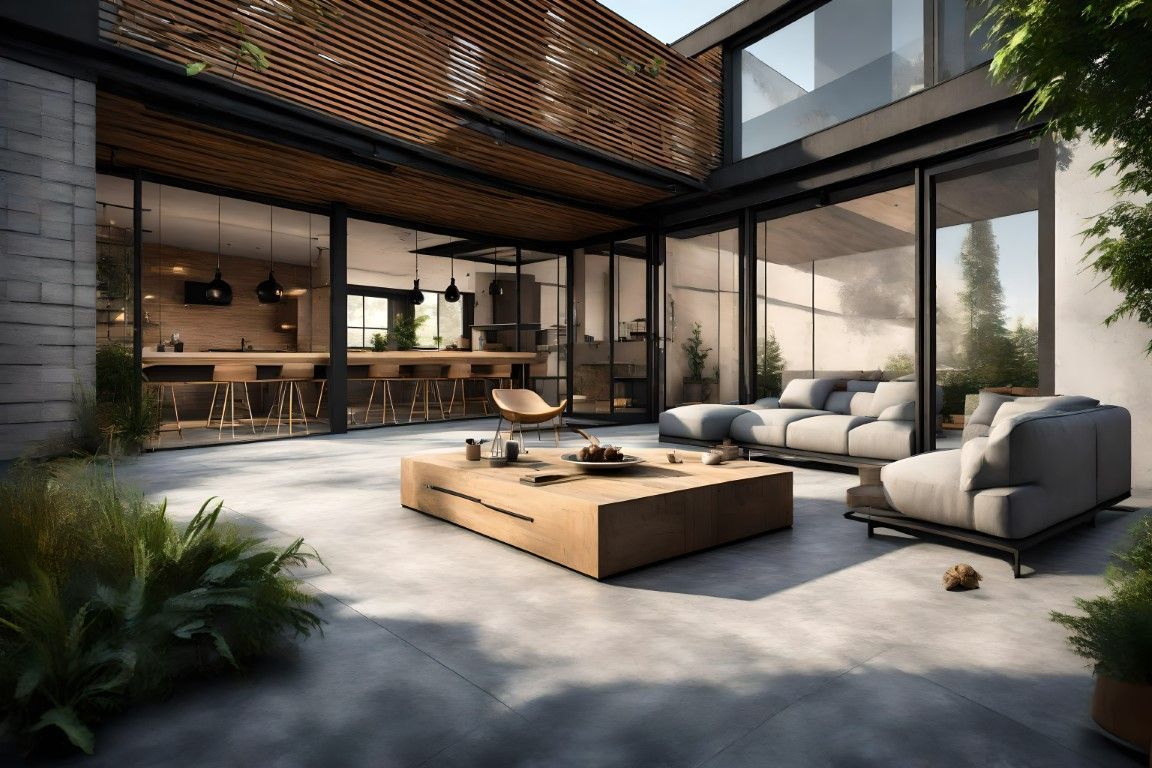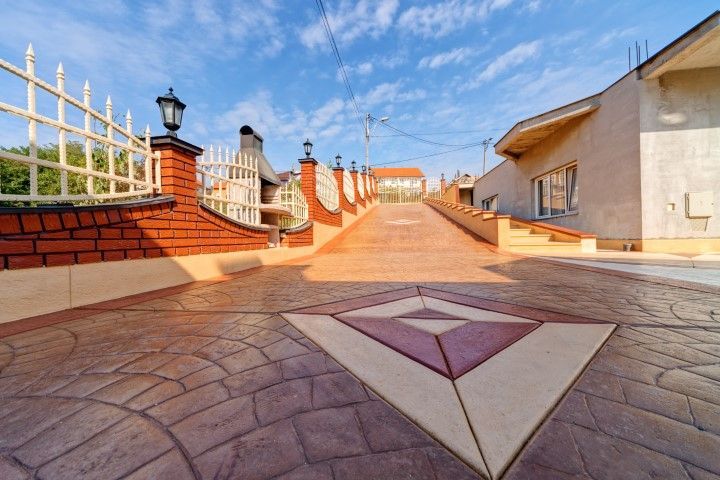Learn how stamped, stained, and decorative concrete can elevate outdoor living spaces.
Your backyard is more than just an outdoor space — it’s an extension of your home. Whether you love hosting gatherings, relaxing in the sun, or creating a stylish retreat, a well-designed concrete patio can transform your backyard into a functional and beautiful outdoor oasis.
Durable, affordable, and customizable, concrete patios are the perfect foundation for any outdoor living area. From sleek modern finishes to rustic, natural looks, here are some of the best concrete patio design ideas to upgrade your backyard.
1. Stamped Concrete for Style and Texture
Stamped concrete patios are one of the most popular ways to elevate your backyard design. This technique allows concrete to mimic natural materials like stone, brick, slate, or wood — without the high maintenance or cost.
Why Homeowners Love It:
Wide range of patterns and colors to match your home’s style.
Durable surface that resists cracking and fading.
Affordable alternative to natural stone or pavers.
Design Tip:
Choose a stone or flagstone pattern for a classic look, or go for wood-grain stamping to create the warmth of wood with the strength of concrete.
2. Stained Concrete for Color and Character
For homeowners who want something unique and eye-catching, stained concrete offers endless color possibilities. Using acid- or water-based stains, your patio can take on warm earth tones, bold colors, or even multi-layered finishes.
Benefits of Stained Concrete:
Adds depth, color, and visual texture.
UV-resistant finishes protect against sun exposure.
Perfect for both modern and rustic outdoor themes.
Pro Tip:
Combine staining with decorative scoring or engraving to create custom borders, geometric designs, or tile-like appearances.
3. Exposed Aggregate for a Natural, Non-Slip Surface
If you love texture and traction, exposed aggregate concrete is a top choice. By revealing the natural stones within the concrete mix, you get a beautiful, pebble-like surface that’s both durable and slip-resistant — ideal for pool decks and patios.
Why It’s Perfect for Backyards:
Great for outdoor entertainment areas and pool surrounds.
Available in various aggregate colors and sizes.
Low-maintenance and weather-resistant.
Design Idea:
Pair exposed aggregate with smooth concrete borders for a modern, polished contrast.
4. Modern Concrete Patios with Clean Lines
Minimalist design continues to trend, and concrete is the ideal material for achieving a sleek, contemporary backyard look. Smooth-finished patios with geometric shapes and subtle tones create a modern outdoor living vibe.
Enhancement Ideas:
Integrate built-in seating, fire pits, or planters.
Use large concrete slabs separated by gravel or grass strips.
Add LED lighting for ambiance and safety at night.
Pro Tip:
Choose light gray or charcoal tones for a high-end aesthetic that complements modern home architecture.
5. Decorative Borders and Multi-Level Patios
Adding decorative borders or varying patio levels can bring structure and elegance to your backyard. A multi-level patio design defines areas for dining, lounging, or grilling — making your outdoor space both practical and stunning.
Why It Works:
Adds dimension and depth to flat backyards.
Defines different activity zones naturally.
Allows you to combine multiple finishes or colors for contrast.
Design Idea:
Use contrasting stamped borders or colored concrete bands to highlight edges and transitions.
6. Integrating Outdoor Features with Concrete
Your concrete patio can be more than just flooring — it can serve as the foundation for a complete outdoor living space.
Consider Adding:
Outdoor kitchens or grilling stations.
Built-in benches or retaining walls.
Fire pits or water features for ambiance.
Pergolas or covered seating areas for year-round enjoyment.
These upgrades not only enhance the usability of your patio but also increase your home’s value and visual appeal.

If you’re looking for a smart way to increase your property’s value in Egypt Lake-Leto, FL, investing in professional concrete work is one of the most effective upgrades you can make. From enhancing curb appeal to improving safety and long-term durability, high-quality concrete surfaces deliver both immediate visual impact and lasting returns. Whether you’re preparing to sell, rent, or simply improve your home, here’s how professional concrete services can significantly boost property value in Egypt Lake-Leto. 🚗 1. Concrete Driveways Create a Strong First Impression Your driveway is one of the first things visitors and potential buyers notice. A professionally installed concrete driveway offers a clean, polished look that instantly elevates curb appeal. Benefits of Concrete Driveways: Long lifespan (20–30+ years) Minimal maintenance compared to asphalt Supports heavy vehicles without cracking Custom finishes like stamped or stained concrete Value Impact: A modern concrete driveway signals quality construction and proper maintenance — two major factors buyers look for. 🌿 2. Concrete Patios Expand Usable Living Space Outdoor living spaces are highly desirable in Florida, and a concrete patio transforms a backyard into a functional extension of the home. Why Concrete Patios Add Value: Creates entertainment and relaxation space Low-maintenance and weather-resistant Customizable with decorative finishes Ideal for outdoor kitchens and seating areas Pro Tip: Decorative concrete patios often deliver one of the highest returns on investment for home upgrades. 🚶 3. Safe, Attractive Walkways Improve Accessibility Cracked or uneven walkways lower property value and pose safety hazards. Professionally poured concrete walkways improve both aesthetics and functionality. Walkway Benefits: Smooth, slip-resistant surfaces ADA-compliant design options Enhanced accessibility for all ages Improved flow across the property Value Impact: Safe, well-designed walkways reduce liability concerns and increase buyer confidence. 🧱 4. Concrete Repair Restores Structural Integrity Damaged concrete sends a message of neglect. Professional concrete repair corrects cracks, sinking, and surface deterioration before they become major issues. Repair Services That Add Value: Crack sealing Slab leveling Resurfacing Drainage correction Pro Tip: Addressing concrete issues early protects your investment and prevents costly replacements later. 🌦️ 5. Built for Florida’s Climate Egypt Lake-Leto’s heat, rain, and humidity demand durable materials. Concrete outperforms many alternatives in Florida conditions when installed and sealed properly. Climate-Resistant Benefits: Withstands heavy rainfall and moisture Resists erosion and shifting soil Reflects heat better than asphalt Reduces maintenance over time Value Impact: Buyers value materials designed for Florida’s environment, making concrete a strong selling point. 🌱 6. Eco-Friendly and Energy-Efficient Benefits Concrete contributes to sustainable building practices — a growing concern among modern homeowners. Eco Advantages of Concrete: Long lifespan reduces material waste Can incorporate recycled materials Reflective surfaces reduce heat buildup Permeable concrete improves drainage These features enhance property appeal while supporting environmentally responsible living. 🛠️ 7. Professional Installation Makes the Difference The true value of concrete comes from professional installation. Proper grading, reinforcement, and finishing ensure durability, compliance, and visual appeal. Why Hire a Professional Concrete Contractor: Code-compliant installations Precise slope and drainage control High-quality materials and finishes Warranty and long-term performance DIY or low-quality work can decrease property value — professional craftsmanship increases it. Conclusion Professional concrete work is one of the most reliable ways to boost property value in Egypt Lake-Leto. From driveways and patios to walkways and repairs, concrete enhances curb appeal, safety, durability, and resale potential — all while standing up to Florida’s demanding climate.

Your driveway is one of the first things people notice when they visit your home — and one of the hardest-working features of your property. Over time, Florida’s mix of intense heat, heavy rains, and shifting soil can cause concrete driveways to deteriorate. If you live in Egypt Lake-Leto, keeping your driveway in good condition isn’t just about appearance — it’s about safety, functionality, and long-term property value. Here are the most important signs that it may be time to repair or replace your old concrete driveway. 🔨 1. Cracks That Are Spreading or Deepening Small hairline cracks are normal, but wide or expanding cracks signal deeper structural issues. In Florida’s humid climate, cracks can widen quickly as water seeps in and erodes the foundation. Cracks That Require Attention: More than ¼ inch wide Running across large sections of the driveway Deep enough to expose aggregate Filled with weeds or moisture When to Repair: Minor cracks less than ¼ inch. When to Replace: Large, spreading cracks that indicate sub-base instability. 🚗 2. Potholes or Sunken Areas Potholes are more than an eyesore — they can damage your vehicle, hold water, and worsen rapidly. In Egypt Lake-Leto, soft or shifting soil can cause sections of the driveway to sink or buckle. Signs of Sinking or Potholes: Uneven surfaces Water pooling in low spots Deep holes forming after rain Pro Tip: If sinking affects more than one area, it may be time for a full driveway replacement rather than patching. 🌧️ 3. Drainage Problems and Water Pooling Florida’s frequent storms make good drainage essential. If your driveway holds water instead of draining, this is a red flag that the surface or base is failing. Issues Caused by Pooling Water: Accelerated cracking Erosion beneath the concrete slab Mold and algae growth, making the surface slippery When to Repair: Minor leveling issues. When to Replace: Large-scale drainage failure or severe erosion. 🕳️ 4. Surface Erosion or Crumbling Edges If the edges of your driveway are crumbling, flaking, or chipping, this is often due to long-term exposure to heat, moisture, and UV rays — all frequent in Egypt Lake-Leto. Common Causes: Improper installation Age-related wear Water damage Heavy vehicle use Edge deterioration typically indicates the driveway is reaching the end of its lifespan. 🏚️ 5. Fading Color and Surface Discoloration While fading alone doesn’t always mean replacement, it can be a sign of weakening concrete — especially when combined with rough texture or thinning sealant. Why This Happens in Egypt Lake-Leto: Intense sun exposure Constant UV breakdown Standing water during rainy season Pro Tip: If fading is paired with cracks or crumbling, replacement may be more cost-effective than repeated repairs. 🧱 6. Your Driveway Is Over 20–30 Years Old Even well-maintained concrete eventually wears out. Most driveways last 20–30 years, but Florida’s weather can shorten that lifespan. If your driveway is approaching this age and showing multiple signs of wear, a full replacement is often the smartest investment. Warning Signs of Aging Concrete: Widespread cracking Uneven sections Crumbling surface Frequent need for repairs 💰 7. Repairs Are Becoming More Frequent If you’re calling for repairs every year, those costs add up quickly. At a certain point, replacing the driveway saves more money and eliminates the ongoing frustration of band-aid fixes. Good Rule of Thumb: If repair costs are 50% or more of the cost of a new driveway, replacement is the better choice. Conclusion Your concrete driveway works hard every day, and Florida’s climate only speeds up wear and tear. Recognizing the early signs of damage can help you protect your home, improve curb appeal, and avoid expensive repairs later on.

For businesses, every decision that impacts cost, maintenance, and longevity matters, and flooring is no exception. While many commercial property owners choose tile, carpet, or vinyl for aesthetics, concrete flooring offers something far more valuable: long-term cost savings and superior performance. Whether you operate a retail store, restaurant, warehouse, or office, concrete floors provide an unbeatable combination of durability, efficiency, and sustainability that can save your business thousands over time. Here’s why more companies are investing in concrete as their go-to flooring choice. 1. Exceptional Durability Reduces Repair Costs Concrete is one of the most durable flooring materials available. When installed and sealed properly, it can withstand heavy foot traffic, machinery, and daily wear without the cracking, warping, or fading common in other materials. Why It Saves Money: Withstands forklifts, carts, and heavy equipment in industrial spaces. Doesn’t chip or peel like epoxy or tile floors. Lasts decades before needing replacement. Pro Tip: A one-time investment in polished or sealed concrete flooring can eliminate frequent repair costs that come with vinyl tiles or laminate, especially in high-traffic commercial areas. 2. Minimal Maintenance and Cleaning Costs Unlike carpets that trap dirt or tiles that require constant grout cleaning, concrete floors are incredibly low-maintenance. Cost-Saving Benefits: Simple cleaning, just dust mopping and occasional wet mopping. No need for waxing, refinishing, or replacement of worn sections. Resistant to stains, spills, and moisture when sealed correctly. Pro Tip: For restaurants, warehouses, or medical facilities, concrete’s non-porous surface makes cleaning faster and more sanitary, reducing both labor and cleaning supply expenses. 3. Energy Efficiency Through Thermal Mass Concrete flooring has a natural ability to absorb, store, and slowly release heat, helping regulate indoor temperatures. This property, known as thermal mass, allows businesses to save significantly on heating and cooling costs. How It Helps Businesses Save: Keeps buildings cooler in summer and warmer in winter. Reduces HVAC use, leading to lower utility bills. Works well with radiant heating systems for added energy efficiency. Pro Tip: Pair polished concrete flooring with LED lighting and reflective finishes to brighten large spaces, reducing the need for excessive artificial lighting. 4. Longevity That Outlasts Other Flooring Materials When comparing lifespan and replacement costs, concrete wins every time. While carpet or vinyl may need replacing every 5–10 years, properly maintained concrete floors can last 50 years or more. Concrete Flooring Lifespan Advantages: No replacement needed every decade. Resistant to daily wear in offices, warehouses, and showrooms. Maintains its polished appearance with minimal upkeep. Pro Tip: Periodic resealing or polishing enhances durability and keeps the surface looking new — extending the floor’s lifespan without major expenses. 5. Eco-Friendly and Sustainable Savings Businesses are increasingly prioritizing sustainable building materials, and concrete is one of the most eco-conscious choices available. Many companies save money by reducing waste and energy usage with concrete flooring. Why It’s Sustainable and Cost-Effective: Concrete can incorporate recycled materials like fly ash or slag. Reflective finishes reduce cooling needs in warm climates. Long lifespan means fewer replacements, less waste and lower environmental impact. Pro Tip: Ask your commercial concrete contractor about green concrete options or low-VOC sealers to enhance sustainability and improve indoor air quality. 6. Boosts Professional Image and Property Value Concrete floors aren’t just functional, they’re visually impressive. Polished and stained finishes can create a modern, sleek aesthetic that enhances brand perception while adding long-term value to your property. Business Benefits: Creates a clean, professional look for clients and employees. Increases commercial property value. Reduces the need for future flooring upgrades. Pro Tip: Customize your concrete flooring with acid stains, dyes, or polished finishes to align with your brand colors or interior design, blending beauty and performance. 7. Lower Total Cost of Ownership When evaluating flooring options, the true cost isn’t just installation, it’s maintenance, repairs, and replacement over decades. Concrete’s combination of longevity, energy efficiency, and minimal maintenance leads to one of the lowest total costs of ownership in the flooring industry. Cost Comparison (Over 20 Years): Flooring Type Average Lifespan Maintenance Level Estimated Long-Term Cost Carpet 5–10 years High $$$ Vinyl Tile 10–15 years Moderate $$ Epoxy Flooring 10–20 years Moderate $$ Concrete Flooring 50+ years Low $ Pro Tip: Concrete’s durability means your investment pays for itself, not in months, but over decades of savings and performance. Conclusion For businesses in retail, hospitality, manufacturing, or office spaces, concrete flooring is more than just a design choice, it’s a financial strategy. Its combination of strength, low maintenance, and energy efficiency makes it one of the smartest long-term investments you can make for your property.

When it comes to building a beautiful and functional patio, homeowners often face one big question: concrete or pavers? Both materials have their appeal, but when it comes to durability, affordability, and design flexibility, concrete patios often come out on top. Whether you’re upgrading your backyard, creating an outdoor dining area, or designing a cozy space for gatherings, choosing the right foundation matters. Here’s why concrete is a smarter, longer-lasting investment for your home patio. 1. Superior Durability and Strength Concrete is one of the strongest and most reliable materials available for patio construction. Unlike pavers, which can shift or loosen over time, a properly poured concrete slab provides a solid, uniform surface that can withstand heavy use and changing weather conditions. Why It Matters: Ideal for high-traffic outdoor areas. Withstands freeze-thaw cycles better than individual pavers. Less risk of tripping or uneven surfaces over time. Pro Tip: For added protection and longevity, ask your contractor about reinforced concrete or sealants designed for outdoor durability. 2. More Cost-Effective Installation While both options can create stunning outdoor spaces, concrete patios typically cost less to install than paver patios. Pavers require individual placement, leveling, and sealing, which increases labor time and expense. Concrete Advantages: Faster, simpler installation process. Lower overall labor and material costs. Long-term savings on maintenance and repairs. Pro Tip: Stamped or stained concrete can replicate the appearance of high-end materials, like stone or brick, at a fraction of the price. 3. Easier Maintenance and Cleaning One of the biggest benefits of concrete patios is their low-maintenance nature. Unlike pavers, which have joints that trap dirt, weeds, and moss, concrete offers a smooth, continuous surface that’s easy to clean and care for. Maintenance Benefits: No need for frequent re-sanding or weed removal. Simple cleaning with mild detergent and water. Occasional sealing keeps it looking brand new. Pro Tip: Apply a quality concrete sealer every 2–3 years to protect against stains, moisture, and fading. 4. Fewer Issues with Shifting and Settling Over time, pavers can shift or become uneven due to ground movement, moisture, or poor installation. This not only looks unsightly but can also create tripping hazards. Why Concrete Performs Better: Forms a single, cohesive surface that resists shifting. Maintains structural integrity through seasonal changes. Requires fewer repairs or adjustments. Pro Tip: Proper site preparation and a strong base ensure your concrete patio remains stable and level for decades. 5. Endless Design and Customization Options Modern concrete is far from plain or boring. Today’s homeowners can choose from a wide variety of textures, patterns, and colors to achieve any look they want. Popular Custom Options Include: Stamped Concrete: Mimics natural stone, tile, or brick. Stained Concrete: Adds depth and color for a unique, elegant finish. Exposed Aggregate: Reveals decorative pebbles for a rustic touch. Pro Tip: Mix finishes, like pairing a stamped border with a smooth interior, for a polished, high-end appearance. 6. Greater Long-Term Value Concrete patios not only cost less upfront but also deliver greater long-term value due to their longevity and lower maintenance needs. A well-installed concrete patio can last 30 years or more, maintaining its appearance and functionality with minimal upkeep. Long-Term Benefits: Lower lifetime cost compared to pavers. Improved home value and curb appeal. Fewer repairs and replacements needed. Pro Tip: Combine your concrete patio with built-in features such as seating walls, fire pits, or planters to create an outdoor living space that boosts property value. 7. Better for Custom Shapes and Large Areas If your patio design includes curves, custom edges, or large continuous surfaces, concrete is far more adaptable than pavers. Pavers can be difficult to install in complex shapes, while concrete can be poured to fit any layout with clean, seamless lines. Why Homeowners Prefer Concrete: Perfect for modern, open-concept backyard designs. Minimizes gaps, creating a cohesive flow. Easily integrates with outdoor kitchens, pools, and garden areas. Pro Tip: Work with an experienced concrete contractor to design a patio that complements your landscaping and architecture. 8. Environmentally Friendly Option Concrete is an eco-friendly choice when installed properly. It uses fewer raw materials than pavers, doesn’t require frequent replacement, and can be made with sustainable or recycled aggregates. Eco Benefits Include: Reduces waste and long-term material use. Reflective finishes help lower heat absorption. Compatible with permeable design options to manage rainwater runoff. Pro Tip: Choose locally sourced concrete and low-VOC sealers to make your patio project even greener. While both concrete and pavers can create stunning outdoor spaces, concrete patios stand out for their strength, affordability, and versatility. With fewer maintenance requirements, smoother finishes, and endless customization options, concrete is the clear winner for homeowners who want a long-lasting, beautiful outdoor retreat.

Florida’s tropical climate brings sunshine, humidity, and frequent rain — and while the weather is great for lush lawns, it can be tough on concrete. Without proper drainage, water can seep under slabs, weaken foundations, and cause cracks, sinking, and costly repairs. Whether it’s your driveway, patio, or walkway, ensuring good water management is essential for protecting your home’s structure and curb appeal. Here’s why proper drainage is so important for concrete in Florida homes and how to make sure your property is built to withstand the elements. 1. Florida’s Climate Creates Constant Water Challenges In Florida, sudden downpours and high groundwater levels are common. If your concrete doesn’t drain properly, standing water can cause: Cracking and erosion as water seeps into small gaps and expands. Foundation settling when water weakens the soil underneath. Surface staining and mildew growth in shaded or low-lying areas. Homes in areas like Tampa, Orlando, and Miami face frequent rainfall and humidity — which makes drainage not just a bonus, but a necessity for long-term concrete performance. 2. Protects Your Concrete from Structural Damage Concrete is strong, but it’s not immune to water damage. Over time, poor drainage can lead to: Undermined foundations as moisture softens the soil beneath slabs. Uneven surfaces or sinking driveways caused by soil erosion. Cracking and spalling, which make the surface rough, unsafe, and unattractive. Proper grading, drains, and installation techniques help prevent these problems before they start — saving you from costly structural repairs later. 3. Prevents Pooling and Slip Hazards Standing water on concrete isn’t just unsightly — it’s dangerous. Driveways and walkways with poor drainage can become slick after rain, creating slip hazards for family and guests. Pool decks and patios without proper slope or drainage can collect puddles that promote algae growth and surface deterioration. Ensuring water flows away from your concrete keeps your property safer, cleaner, and easier to maintain. 4. Increases Longevity and Property Value Concrete that drains properly lasts longer and maintains its appearance for years. Well-drained surfaces: Require less maintenance and fewer repairs. Stay cleaner and brighter by preventing mold and mildew buildup. Enhance curb appeal and boost your home’s resale value. Homebuyers in Florida often look for properties with durable, well-maintained exteriors — and proper concrete drainage is a key factor. 5. How to Improve Concrete Drainage If you’re building or upgrading concrete on your property, here’s what to keep in mind: Ensure Proper Grading: Concrete should be sloped slightly away from your home to direct water flow. Install Drainage Solutions: French drains, channel drains, or catch basins help redirect excess water. Seal and Maintain: Regular sealing protects against moisture penetration and extends lifespan. Work with Professionals: An experienced Florida concrete company understands local soil conditions and rainfall patterns — ensuring your project is built for durability. Proper drainage isn’t just a finishing touch — it’s a crucial part of every concrete project in Florida. With the state’s heavy rainfall and high humidity, smart drainage design keeps your concrete strong, beautiful, and safe year after year.

